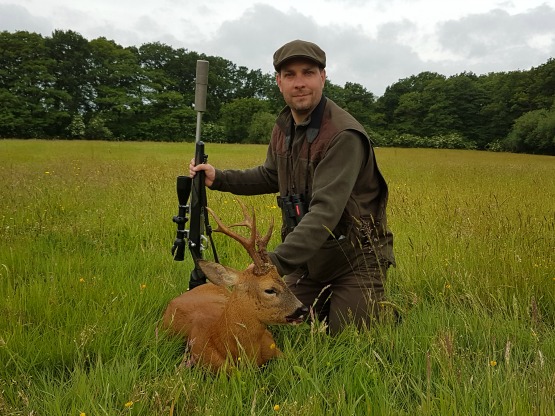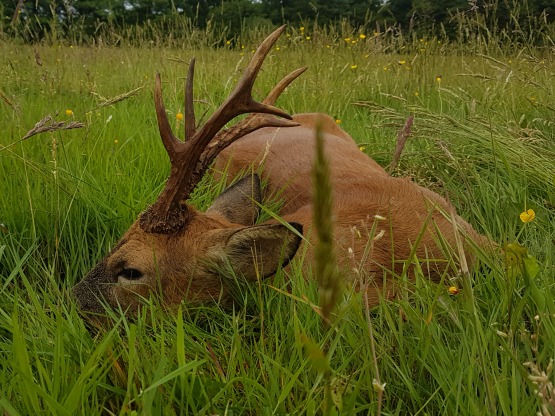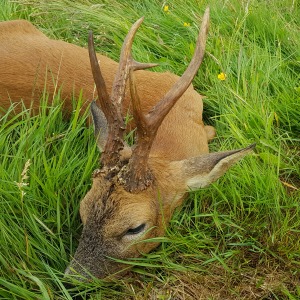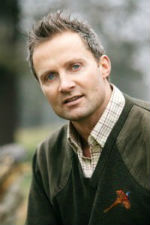With the start of the 2017 Roe rut now only days away Peter Jones takes a look at an especially large Roebuck shot on CDS grounds and the variables that may have contributed to such a large head.

(Above: A happy client with what is likley to be amongst the largest Roebuck trophies shot in the UK this year)
Just a short time ago I was delighted to be involved in the grassing of one of the largest Roebuck to have been shot on County Deer Stalking grounds in recent years. The trophy is still ‘drying out’ (the required period is 3 months) and so I am unable to give an exact score, however initial estimates are that the uncut trophy weight is likely to exceed 600 grams. With Gold medals usually being awarded for weights in excess of 540 grams, it is not only likely to be a solid Gold, but is also likely to be amongst one of the largest Roebuck shot in the Uk this year. So what were the variables that contributed to such a large trophy Roebuck?
Over the years I have heard deer managers refer to numerous variables that they consider contributory to producing large trophy Roe heads. Amongst these is the weather. In short, following a particularly hard winter the crop of Roebuck are less likely to be as impressive as following mild winters. The logic follows, that the region of the UK must also play a significant part, with larger Roebuck tending to come from the more southern counties of the UK, where the climate is a little more forgiving than in the northern climes. Indeed a cursory look at the record books reveal, that the majority of medal winning heads appear to originate in the southern counties. Yes some northern counties feature prominently, such as Yorkshire, however Yorkshire is an awfully big county and so the sheer size of the county would account for the higher proportion of medal heads.

(Above: It's not all about weight, the antlers show excellent symmetry and are in excess of 11.5" in length with good pearling and colour)
Whilst weather is important, it is not the whole story. The quality and availability of vegetation during the antler growing phase, and the richness of the mineral content of the soil will also logically contribute to larger antler growth, with a studies showing that calcium and phosphorus are the minerals most needed . It will usually follow that the larger, heavier bucks tend to develop more impressive antlers. Therefore the deer that graze and browse at plentiful lush vegetation high in minerals will of course tend to develop in size and therefore exhibit larger antlers. Compare the average larder weight of Roebuck taken from the pasture lands of say Wiltshire, with a buck from the Scottish Highlands and the polarisation of body weight and condition will quickly become apparent.
 These variables undoubtedly play a part in antler development however, in the UK we are the deer’s only predator and as such as deer managers we must appreciate that we also play a fundamental part in the deer’s evolution. Sound selection policies are therefore fundamental in allowing a population of deer to develop. And amongst Roe, who are notoriously difficult to age, and who’s antler development will vary significantly from one year to the next, it is enough to do this on the basis of age and body condition. With the broad age categories of; ‘yearling’, ‘middle age’ and ‘old’, being employed, and culling being broadly carried out in the proportions of 60% yearling 20% middle age and 20% old.
These variables undoubtedly play a part in antler development however, in the UK we are the deer’s only predator and as such as deer managers we must appreciate that we also play a fundamental part in the deer’s evolution. Sound selection policies are therefore fundamental in allowing a population of deer to develop. And amongst Roe, who are notoriously difficult to age, and who’s antler development will vary significantly from one year to the next, it is enough to do this on the basis of age and body condition. With the broad age categories of; ‘yearling’, ‘middle age’ and ‘old’, being employed, and culling being broadly carried out in the proportions of 60% yearling 20% middle age and 20% old.
So is that it? Are these the relatively simple variables that are key to achieving large Roebuck trophies? Well, yes in the main. However in addition to these variables it is my firm belief that one of the overriding variables often ignored by deer managers is ‘pressure’. In our keenness to pursue our hobby we are often inclined to ignore the mounting pressure and resulting stress that we exert on the deer that we stalk. This I suspect is especially true amongst Roe, with the ‘open season’ for either one sex or the other resulting in the species as a whole being pursued 365 days a year. The pressure that we exert on Roe manifests itself as stress, and as with all animals stress is a huge inhibitor to growth and proper development. I believe it to be no coincidences that the Gold medal shot just a few short weeks ago, came from an area of CDS grounds that we had left undisturbed for the last 18 months. Therefore for those professional stalkers who are interested in achieving large medal heads for their select clients, a deer management plan that employs a policy of ‘rotation’ and ‘set aside’ might also serve well in achieving the objective.
 For more information from Peter about how to measure a Roebuck trophy follow this link:how-to-measure-a-trophy
For more information from Peter about how to measure a Roebuck trophy follow this link:how-to-measure-a-trophy
If you feel that your trophy may be worthy of a medal and would like to have the trophy measured formally then follow this link for a list of CIC measurers: cic-measurers
If you would like to stalk Roebuck with County Deer Stalking then contact James Mott: 0203 981 0159 / 07789 747709 or email:



















